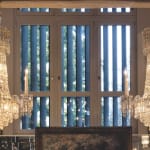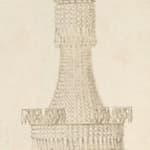
Credit Line: Supported by the Friends of the V&A
John Blades (attributed to)
Literature
Martin Mortimer, “The English Glass Chandelier”, 1999, pp. p. 136, pl. 80 and p. 137, pl. 81
A very beautiful and rare pair of Regency cut glass and gilt bronze six-light chandeliers attributed to John Blades, most probably after a design by John Buonarotti Papworth, each with a vase-shaped glass corona above a circular gilt bronze ring hung with icicle drops and supporting graduated rule-cut drops, the six scrolled branches, each with glass drip-pans and tier of rule-cut drops, the basket with tiers of rule drops and a faceted ball pendant
London, date circa 1820
Height 105 cm, diameter 70 cm. each.
Distinguished by their brilliance and sheer elegance, these cut glass chandeliers share many similarities with examples made by the London glass manufacturer and merchant John Blades (b. c. 1751 d. 1829) after designs by the architect John Buonarotti Papworth (1775-1847). As a maker of chandeliers, Blades was unusual, perhaps even unique, in employing a designer, yet it was to his advantage since Papworth introduced a number of innovative designs. Among them, and as we see here, was the rule-cut drop, more commonly known as the ‘lob’, in which a straight-sided drop was cut with long parallel facets and were hung in rows to increase brilliance. The present chandeliers compare very closely to a design, appearing in a leather-bound pattern-book of circa 1824, now in the Victoria and Albert Museum, London (E.761:44-2008). The pattern-book, titled “Modeles et Tailles de Cristaux Anglais” or (models and patterns of English crystal), included designs for English glass table-ware, candelabra, chandeliers, and metal-mounted pendant lamps, for the French retail trade. Although the Victoria and Albert Museum note that it is impossible to say with certainty as to who created the designs, Blades is considered a very probably candidate. In his book about English chandeliers, Martin Mortimer illustrates another similar chandelier as well as a design, signed and dated John Blades 1828, for a similar ten or twelve-light chandelier showing the structure of a Blades frame as well as the mini-basket under each candle arm (Martin Mortimer, “The English Glass Chandelier”, 1999, pp. p. 136, pl. 80 and p. 137, pl. 81).
John Blades was first mentioned in the “London Guide” of 1783, as based at 5 Ludgate Hill, where he remained until his death in 1829 when his business was continued by his sons up until 1857. Papworth not only designed his chandeliers, candelabra, lamps and similar artefacts but also designed a new showroom for the firm in 1823 which can be seen in a print, reproduced in “Akerman’s Depository of the Arts”, showing the showroom filled to capacity with a plethora of glass chandeliers and other glassware plus Blades himself, standing to once side (Mortimer, op. cit. p. 138, pl. 82). As one of the leading Regency glass manufacturers, his clients included George III as well as the Prince Regent (later George IV) and the Shah of Persia while one of his chandeliers hangs in Spencer House, London.
Blades, whose portrait was painted by Sir William Beechey, was appointed Sheriff of London and Middlesex, 1812–13. He married Hannah Hobson at St Bride’s Church, Fleet Street where he was eventually buried and where his memorial stone can be seen in the crypt. Such was his success that at his death in 1829 he left personal property valued at about £140,000, as well as Severndroog Castle near Shooter’s Hill, his estate at Brockwell Hall, Brixton and his London showroom and workshop.


